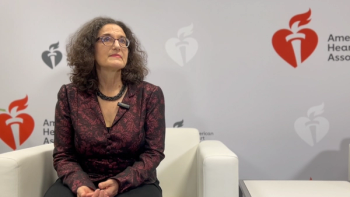
The Green Environment, Air Pollution, and Respiratory Health
Increasing air pollution and climate change have an impact on respiratory health and mortality, explained speakers in 2 sessions on the environment and respiratory diseases at the European Respiratory Society International Congress 2021.
Increasing air pollution and climate change have an impact on respiratory health and mortality, explained speakers in 2 sessions on the environment and respiratory diseases at the
Barbara Hoffmann, MD, MPH, professor of environmental epidemiology, Institute for Occupational, Social, and Environmental Medicine, Heinrich-Heine-University of Dusseldorf, highlighted the need for clean air when it comes to asthma and allergy.
All over Europe, there are hot spots of pollution by urban areas in Italy, Belgium, the Netherlands, France, and Spain. During lockdown, decreased industrial and transport-related emissions led to improved air in these areas, she noted. However, while the air was cleaner than what we’re used to, it still wasn’t actually clean.
Air pollution has a big impact on health, although it doesn’t always get the recognition it should. It actually ranks fourth among the major risk factors for morbidity and mortality, after high blood pressure, smoking, and bad diet.1 “Air pollution affects almost every single organ system in our body either directly or indirectly,” Hoffmann said.
In the short term, there is strong evidence that air pollution—specifically nitrogen dioxide (NO2) and particulate matter 2.5 (PM2.5)—affects asthma exacerbations. In the hours and days after high NO2 and PM2.5 concentrations there are increased hospitalizations, emergency department and physician visits, pulmonary inflammation, and allergic sensitization, as well as lung function decrements, Hoffmann said.
In the long term, there’s also strong evidence that air pollution increases respiratory and chronic obstructive pulmonary disease (COPD) mortality; however, the evidence is not as consistent on incidence of asthma and COPD as a result of air pollution.
In the ELAPSE study,2 investigators analyzed long-term effects of air pollution on mortality, lung cancer incidence, cardiovascular disease events, and respiratory disease using advanced exposure modeling for NO2 and PM2.5, black carbon, and ozone. They evaluated a selection of adult European cohorts and found that all of the cohorts were located in regions below the regulatory limit value for PM2.5 and the northern cohorts were below World Health Organization guidelines for PM2.5.
Despite relatively low concentrations of pollution, they saw strong and consistent effects on the investigated diseases, Hoffmann said. The effects on asthma and COPD were larger than had been shown in previous studies, too.
“Therefore, even below [air pollution] recommendations, we can see these effects,” she said.
In children, studies have shown the large and consistent effect of traffic-related air pollution on asthma-related incidents. One showed that even a small increase in NO2 exposure contributed to the development of asthma3 and another found that outdoor air pollution contributed to more than 300,000 additional cases of childhood asthma in Europe every year.4
“So, that’s quite a huge burden of disease,” Hoffmann said.
There is more evidence that long-term exposure to air pollution increases the incidence of respiratory disease in children and adults, she noted, and regulatory action is needed. In 2022, the European Union is going to review its air quality directive, and she hopes that’s when new regulation will be introduced.
“We think that this is a chance for achieving large health benefits in Europe,” Hoffmann said.
In a different session, Elaine Fuertes, PhD, MSc, research fellow, National Heart & Lung Institute, Imperial College London, specifically looked at green environment and respiratory health. Green environment is measured through 2 ways:
- Greenness: the presence of green vegetation, which is measured based on the amount of green vegetation
- Green space: the presence or distance to structured or unstructured green areas, such as forests, parks, or cemeteries; this looks at if green areas are present, but not the amount of vegetation
There is some body of evidence that indicates the green environment might have a role on various respiratory outcomes, but the evidence is inconsistent. There were 2 literature reviews analyzing studies on the evidence of the relationship between residential greenness and allergic respiratory disease in children.5,6 The 2 studies found a lot of heterogeneity across the studies they reviewed and they both decided that the inconsistencies across the studies were too large to be able to come to any conclusions.
Evidence is beginning to build on lung function, though, Fuertes said. Her own study,7 which looked at the effect of green environment on lung function, showed children and young adults living “in areas that had higher vegetation tended to have higher lung function all the way up to 24 years of age,” she said.
In addition, the study found that the beneficial association of vegetation on lung function seemed to be greater in urban areas and areas of high particulate matter 10 concentrations.
A Chinese study also found a beneficial association between vegetation factors and lung function, but it only reported beneficial associations in areas of low to moderate pollution.8
Fuertes noted that the studies may seem to have conflicting results, but she speculated that the levels of pollution in low to moderate areas of pollution in China may be what is considered high in the United Kingdom. However, this is difficult to confirm since the studies analyzed different pollutants.
Research has shown that plants in areas with high air pollution tend to release a higher number of pollen grains and have higher allergen levels as a result of the interaction with air pollution. This is important when considering the impact of climate change.9 Air pollution that increases global warming also results in an increased duration, length, and severity of pollen season and even alters the geographical distribution of plants, which may result in new sensitization among usually unexposed individuals.
Ultimately, it seems that green environment influences respiratory health, but the existing evidence is conflicting; however, evidence seems fairly certain now that air pollution adversely affects respiratory health directly and also through interactions with airborne allergens, Fuertes concluded.
“Increasing air pollution and ongoing climate change will increase health impacts of outdoor allergens in those sensitized,” she said.
References
1. Thurston GD, Kipen H, Annesi-Maesano I, et al. A joint ERS/ATS policy statement: what constitutes an adverse health effect of air pollution? An analytical framework. Eur Respir J. 2017;49(1):1600419. doi:10.1183/13993003.00419-2016
2. Liu S, Therming Jørgensen J, Ljungman P, et al. Long-term exposure to low-level air pollution and incidence of asthma: the ELAPSE project. Eur Respir J. 2021;57(6):2003099. doi:10.1183/13993003.03099-2020
3. Khreis H, Kelly C, Tate J, Parslow R, Lucas K, Nieuwenhuijsen M. Exposure to traffic-related air pollution and risk of development of childhood asthma: A systematic review and meta-analysis. Environ Int. 2017;100:1-31. doi:10.1016/j.envint.2016.11.012
4. Khreis H, Cirach M, Mueller N, et al. Outdoor air pollution and the burden of childhood asthma across Europe. Eur Respir J. 2019;54(4):1802194. doi:10.1183/13993003.02194-2018
5. Lambert KA, Bowatte G, Tham R, et al. Residential greenness and allergic respiratory diseases in children and adolescents - a systematic review and meta-analysis. Environ Res. 2017;159:212-221. doi:10.1016/j.envres.2017.08.002
6. Ferrante G, Asta F, Cilluffo G, De Sario M, Michelozzi P, La Grutta S. The effect of residential urban greenness on allergic respiratory diseases in youth: A narrative review. World Allergy Organ J. 2020;13(1):100096. doi:10.1016/j.waojou.2019.100096
7. Fuertes E, Markevych I, Thomas R, et al. Residential greenspace and lung function up to 24 years of age: The ALSPAC birth cohort. Environ Int. 2020;140:105749. doi:10.1016/j.envint.2020.105749
8. Zhou M, Huang Y, Li G. Changes in the concentration of air pollutants before and after the COVID-19 blockade period and their correlation with vegetation coverage. Environ Sci Pollut Res Int. 2021;28(18):23405-23419. doi:10.1007/s11356-020-12164-2
9. Eguiluz-Gracia I, Mathioudakis AG, Bartel S, et al. The need for clean air: The way air pollution and climate change affect allergic rhinitis and asthma. Allergy. 2020;75(9):2170-2184. doi:10.1111/all.14177
Newsletter
Stay ahead of policy, cost, and value—subscribe to AJMC for expert insights at the intersection of clinical care and health economics.















































